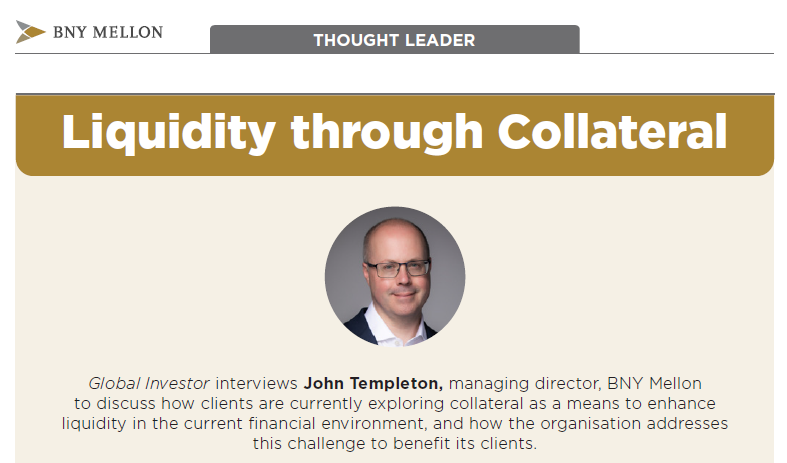Collaboration: Innovate, validate and implement

Collaboration: Innovate, validate and implement
Global Investor speaks to, Nick Short, Chief Operating Officer at HQLAᵡ.
This Thought Leadership article is part of the 2022 Autumn Magazine, which can be accessed here.
HQLAᵡ has partnered with many major players in the securities lending space in recent years. Can you share with readers what other initiatives you have in the pipeline?
From inception of our company, we have prided ourselves for being a platform designed by the market for the market. Collaborating with industry players to solve for business problems using distributed ledger technology
The key driver for our collaboration across the industry is to solve specific industry pain points. Along with our clients, we come up with new ideas, innovate around them and run a feasibility process. We always involve the clients to make sure that the idea works in scale. If it does, the next step is usually to design and implement a Minimal Viable Product (MVP) in production.
The original premise of our platform was to use the HQLAᵡ operating model to enable bank clients to seamlessly exchange ownership of baskets of securities across disparate collateral pools at precise moments in time whilst keeping the underlying securities static. Our initial product offering was focused on bank-to-bank upgrade/ downgrade collateral transformation transactions, but we have more recently extended this initial product offering to include participants who are agency securities lenders, which we’re very excited about.
Our product development roadmap is very much focused on expanding platform functionality to enable our clients to benefit from enhanced collateral mobility across a number of new use cases. With that in mind, we are working on some new collaboration opportunities with other industry platforms. We consider
ourselves a post-trade processing solution, which means that we will be connecting with trade capture solutions that allow market participants to agree trades and/or exposures, which are then routed to our platform. For example, we have recently entered into a collaboration agreement with Wematch to pave the way for common clients to be able to input securities lending indications of interest on the Wematch trade execution platform, with post-trade settlement confirmed by our platform.
We are also working on a variation margin use case for derivatives, in collaboration with both sell-side and buy-side clients. We’re extending the basic premise of our platform for the purposes of over-the-counter derivatives variation margining, as well as a more efficient way for institutions to manage ‘substitution’ - the collateral backwards and forwards that happens during those flows. Finally, we are pursuing several collaborative solutions to extend our product set beyond noncash securities lending transactions to also include repo transactions. We are very excited about the opportunities to collaborate and interoperate with other DLT platforms in the digitized cash space.
How has technology influenced the liquidity and collateral management space?
Since the financial crisis, a lot of the focus across the industry has been on building solutions to help deal with regulatory reporting. But in recent years, we’ve noticed an increasing emphasis on ‘pure innovation’ – by that, I mean, innovation not driven directly by regulation. For example, this could be helping institutions react to market events more efficiently and support their ability to see and deal with events in real-time. This is a need that we have seen in recent years, for instance.
We’re also seeing institutions getting more and more interested in how to manage their collateral more efficiently and the different types of solutions out there, including triparty of course. One of the reasons why HQLAᵡ came to be in the first place was to help institutions manage their collateral buffers more effectively – for instance, the liquidity coverage ratio
On that point, collateral optimisation is an area where there has also been evolution. That is evidenced by the growing number of tech solutions in this space. Organisations need to visualise their collateral, understand how they can execute ownership transfers of that collateral, and then optimise accordingly. We consider these the three pillars of collateral management. One of the things that we do is provide the ability to carry out change of ownership flexibly, at precise moments in time rather than to the nearest day. This could be at 8:15am or 11pm, for example. This flexibility is attractive to our clients. It is also an improvement on today’s market.
We have also noticed greater centralisation of collateral management across different areas within an institution. This is particularly true for banks, which may have multiple desks, businesses and functions with sometimes different objectives e.g., the treasury function, operations, the repo desk, the equity finance desk, sometimes an asset management arm, and the collateral needed for derivatives. Bringing all these collateral needs together optimally can be complex which is why it’s an area that will continue to benefit from innovation.
Looking specifically at DLT now, what areas will it have the most impact in?
DLT has seen a steady but consistent evolution rather than a so-called big bang approach. The HQLAᵡ platform is in sync with that thinking because we are offering a layer of DLT on top of the existing market infrastructure to achieve something better for the industry. We are not changing the underlying securities safekeeping infrastructure, or indeed the existing rules that govern that infrastructure.
Frictionless mobilisation, as it is sometimes referred to, is an area where DLT has tremendous potential to help. This ties back to what I said before about moving collateral around more efficiently. DLT can also support collateral ownership change with certainty. For example, if I do a trade with you, in the current system, what happens if neither of us delivers what we are supposed to? The transactions fails. This is something that DLT can help address by providing certainty that you have the collateral up front that you intend to give to me, and vice versa.
More generally, DLT will have an impact on consistency of information as well. Going back to our previous example, if you and I do a trade, we each record it in our separate systems. We then need to reconcile our respective information on an ongoing basis, which can be time-consuming. Instead, if we both agree to use the same system to represent the trade we have just done, it is so much more efficient. An extension of that is around collateral valuation, which needs to be done in a consistent way when it comes to pricing, reconciliation, and representation of various schedules.
As I said, HQLAᵡ’s operating model is based on providing a layer of interoperability across disparate collateral pools and tri-party agents. We think that additional innovation will be achieved by collaborating with other tech providers as well as other DLT ledgers too. This is something which has already started, and we’re excited about several collaborations that we’re engaged in along these lines.
We also value other providers offering similar functionality to the HQLAᵡ platform. This is because it further validates that what we’re building makes sense and that there’s a clear need for it in the collateral management industry.
Overall, whilst we’re proud of what we’ve built so far, we’re also very excited about what’s possible down the road in terms of innovation and collaboration. We can’t wait to make it happen!
Found this useful?
Take a complimentary trial of the FOW Marketing Intelligence Platform – the comprehensive source of news and analysis across the buy- and sell- side.
Gain access to:
- A single source of in-depth news, insight and analysis across Asset Management, Securities Finance, Custody, Fund Services and Derivatives
- Our interactive database, optimized to enable you to summarise data and build graphs outlining market activity
- Exclusive whitepapers, supplements and industry analysis curated and published by Futures & Options World
- Breaking news, daily and weekly alerts on the markets most relevant to you





